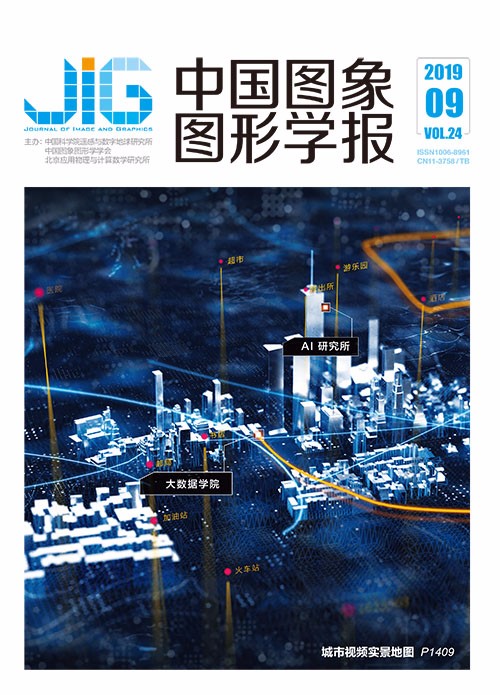
U-net与Dense-net相结合的视网膜血管提取
徐光柱1,2, 胡松1, 陈莎1, 陈鹏1,2, 周军3, 雷帮军1,2(1.三峡大学计算机与信息学院, 宜昌 443002;2.湖北省水电工程智能视觉监测重点实验室, 宜昌 443002;3.三峡大学第一临床医学院超声科, 宜昌 443002) 摘 要
目的 视网膜血管健康状况的自动分析对糖尿病、心脑血管疾病以及多种眼科疾病的快速无创诊断具有重要参考价值。视网膜图像中血管网络结构复杂且图像背景亮度不均使得血管区域的准确自动提取具有较大难度。本文通过使用具有对称全卷积结构的U-net深度神经网络实现视网膜血管的高精度分割。方法 基于U-net网络中的层次化对称结构和Dense-net网络中的稠密连接方式,提出一种改进的适用于视网膜血管精准提取的深度神经网络模型。首先使用白化预处理技术弱化原始彩色眼底图像中的亮度不均,增强图像中血管区域的对比度;接着对数据集进行随机旋转、Gamma变换操作实现数据增广;然后将每一幅图像随机分割成若干较小的图块,用于减小模型参数规模,降低训练难度。结果 使用多种性能指标对训练后的模型进行综合评定,模型在DRIVE数据集上的灵敏度、特异性、准确率和AUC(area under the curve)分别达到0.740 9、0.992 9、0.970 7和0.917 1。所提算法与目前主流方法进行了全面比较,结果显示本文算法各项性能指标均表现良好。结论 本文针对视网膜图像中血管区域高精度自动提取难度大的问题,提出了一种具有稠密连接方式的对称全卷积神经网络改进模型。结果表明该模型在视网膜血管分割中能够达到良好效果,具有较好的研究及应用价值。
关键词
Retinal blood vessel extraction by combining U-net and Dense-net
Xu Guangzhu1,2, Hu Song1, Chen Sha1, Chen Peng1,2, Zhou Jun3, Lei Bangjun1,2(1.College of Computer and Information Technology, China Three Gorges University, Yichang 443002, China;2.Hubei Key Laboratory of Intelligent Vision Based Monitoring for Hydroelectric Engineering, Yichang 443002, China;3.Department of Diagnostic Utrasound, the First College of Clinical Medical Science, China Three Gorges University, Yichang 443002, China) Abstract
Objective The automatic analysis of retinal vascular health status is a fundamental research topic in the area of fundus image processing. Analysis results can supply significant reference information for ophthalmologists to diagnose rapidly and noninvasively a variety of retinal pathologies, such as diabetes, glaucoma, hypertension, and diseases related to the brain and heart stocks. Although great progress has been achieved in the past decades, accurate automatic retinal vessel extraction remains a challenging problem due to the complex vascular network structure of retina vessels, uneven image background illumination, and random noises introduced by optical apparatuses. The traditional unsupervised retinal vessel segmentation methods generally identify retinal vessels with matched filters, vessel tractors, or templates designed artificially according to the vessel shape or prior information of a retinal image. Conversional supervised learning-based retinal vessel extraction algorithms generally consider artifact features as input and train shallow models, such as support vector machine, K-nearest neighbor classifiers, and traditional artificial neural networks. These models perform effectively in the case of normal retinal images with high-quality illumination and contrast. However, because of the representation limit of artificially designed features, these traditional vessel extraction methods fail when fundus vessels have low contrast with respect to the retinal background or are near nonvascular structures, such as the optic disk and fovea region. Recently, deep learning technology with multifarious convolutional neural networks has been widely applied to medical image processing and has achieved the most state-of-the-art performance due to its efficient and robust self-learned features. A series of new advances in retinal image processing has been achieved with deep learning networks. To help advance the research in this field, we adopt a deep neural network called U-net, which has a symmetrical full convolutional structure, and a dense connection to achieve an accurate end-to-end extraction of retinal vessels. Method A specially modified deep neural network for accurate retinal vessel extraction is proposed based on hierarchically symmetrical structure of the U-net model and the dense connection used in the Dense-net model. The introduction of the hierarchical symmetrical structure empowers the proposed model to perceive the coarse-grained and fine-grained image features through symmetrical down-sampling and up-sampling operations. At the same time, the adoption of a dense connection facilitates multiscale feature combination across different layers, including short connections of consecutive layers and skip connections over non-adjacent layers. This feature combination strategy can utilize comprehensive retina image information and enable the entire network to learn efficient and robust features rapidly. To accelerate the training convergence and enhance the generalization of the proposed neural network, we implement image preprocessing and data augmentation prior to model training. The problem of uneven background illumination is alleviated by the whitening operation, which calculates the average value and standard deviation of each input image channel and subtracts them from each pixel of the corresponding input image channel. Then, data augmentation is achieved by random rotation and gamma correction to generate more images than the raw input dataset scale. Subsequently, each image is divided into a mass of random patches with a certain degree of overlap. This operation can reduce the parameter scale dramatically and alleviate the training of the modified neural network greatly. Finally, these image patches are entered our neural network as a feeding group to be trained iteratively. Result The modified U-net, like the deep neural network model, adopts dense connections to effectively identify and enhance actual retinal vessels at different scales and suppress background simultaneously. To evaluate the proposed model's performance quantitatively, we employ the public dataset called DRIVE, which is one of the most rarely used retina vessel segmentation evaluation datasets. DRIVE comprises 40 images with manual segmentation benchmarks and is divided into a training and a test set, each containing 20 images. In our evaluation, four performance indices are used to assess the proposed method thoroughly:accuracy (ACC), sensitivity (SE), specificity (SP), and area under a curve (AUC), all of which are widely accepted evaluation indices for retina vessel segmentation. The comprehensive experiments show that ACC, SE, SP, and AUC of the proposed algorithm for the DRIVE dataset reach 0.970 7, 0.740 9, 0.992 9, and 0.917 1, respectively. Compared with other state-of-the-art methods, our model presents competitive performance. The accuracy of the proposed model structure can shorten the training time dramatically; it only requires five epochs to converge and approximately one-tenth of time, the same as the initial U-net model. This contribution of the dense connection and batch normalization is used in our modified model. Conclusion A specially designed deep neural network for retinal vessel extraction is proposed to address the problems caused by the low contrast of the retinal vascular structure resulting from their background and uneven illumination. The main contributions of this modified model lie in its symmetrical structure and its dense connection over non-adjacent layers. In addition, the data augmentation with random rotation, which is only available for retina images given that the retina area is a circular-like disk, and the addition of batch normalization in the model contribute to the rapid training convergence and high accuracy of vessel segmentation. Experimental results on a widely used open dataset demonstrate that the proposed modified neural network can deal with these problems and achieve accurate retinal vessel segmentation. Compared with other mainstream deep learning algorithms, the proposed method shows enhanced retinal vessel segmentation accuracy and robustness and presents promising potential in retinal image processing.
Keywords
|



 中国图象图形学报 │ 京ICP备05080539号-4 │ 本系统由
中国图象图形学报 │ 京ICP备05080539号-4 │ 本系统由